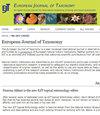Bumblebees with big teeth: revising the subgenus Alpigenobombus with the good, the bad and the ugly of numts (Hymenoptera: Apidae)
IF 1.1
3区 生物学
Q3 ENTOMOLOGY
引用次数: 0
Abstract
The mountain bumblebees of the subgenus Alpigenobombus Skorikov, 1914, are uniquely distinctive because the females have enlarged mandibles with six large, evenly spaced teeth, which they use to bite holes in long-corolla flowers for nectar robbing. Recognition of species in this subgenus has been uncertain, with names used in various combinations. To revise the species, we examined COI-like barcodes for evidence of species’ gene coalescents using MrBayes and PTP and we compare the coalescent groups with morphological variation for integrative assessment. While we seek to include only orthologous barcodes (the ‘good’) and exclude all of the more strongly divergent barcode-like numts (the ‘bad’), for some nominal taxa only low-divergence numts could be obtained (the ‘ugly’). For taxa with no orthologous sequences available, using a minimum number of the lowest divergence numts did yield coalescent candidates for species that were consistent with morphologically diagnosable groups. These results agree in recognising 11 species within this subgenus, supporting: (1) recognising the widespread European Bombus mastrucatus Gerstaecker, 1869 stat. rev. as a species separate from the west Asian B. wurflenii Radoszkowski, 1860 s. str.; (2) the recently recognised B. rainai Williams, 2022, as a species separate from B. kashmirensis Friese, 1909, within the western Himalaya; (3) the recognition once again of B. sikkimi Friese, 1918 stat. rev. and B. validus Friese, 1905 stat. rev. as species separate from B. nobilis Friese, 1905 s. str. within the eastern Himalaya and Hengduan regions; (4) confirming the recognition of B. angustus Chiu, 1948, B. breviceps Smith, 1852 s. lat., B. genalis Friese, 1918, and B. grahami (Frison, 1933) as separate species within the Himalaya, China, and Southeast Asia; (5) recognising the conspecificity of the nominal taxa (not species) channicus Gribodo, 1892 (Southeast Asia) and dentatus Handlirsch, 1888 (Himalaya) as parts of the species B. breviceps s. lat. (southern and eastern China); and (6) recognising the conspecificity of the rare taxon beresovskii (Skorikov, 1933) syn. n. as part of the species B. grahami within China. Nectar robbing by bumblebees is reviewed briefly and prospects for future research discussed.大齿大黄蜂:对大齿大黄蜂亚属的修正(膜翅目:蜂科)
1914年Alpigenobombus Skorikov亚属的山大黄蜂是独一无二的,因为雌性的下颌骨很大,有六颗均匀分布的大牙齿,它们用这些牙齿在长花冠的花朵上咬洞以获取花蜜。对这个亚属的物种的识别一直不确定,在各种组合中使用了名称。为了修正物种,我们使用MrBayes和PTP检查了coi样条形码,以寻找物种基因聚结的证据,并将聚结组与形态学差异进行了比较,以进行综合评估。虽然我们试图只包括同源条形码(“好”),并排除所有更强烈发散的条形码样numts(“坏”),但对于一些名义分类群,只能获得低发散numts(“丑”)。对于没有同源序列的分类群,使用最小数量的最低分化数确实产生了与形态学可诊断群一致的候选物种。这些结果一致地确认了该亚属中的11种,支持:(1)确认广泛分布的欧洲Bombus mastrucatus Gerstaecker, 1869 stat. rev.作为一个独立于西亚B. wurflenii Radoszkowski, 1860 s. str.;(2)最近发现的B. rainai Williams(2022),作为与B. kashmirensis Friese(1909)分离的一个物种,分布在西喜马拉雅地区;(3)再次确认B. sikkimi Friese, 1918 stat. rev.和B. validus Friese, 1905 stat. rev.是东喜马拉雅和横断地区从B. nobilis Friese, 1905 s. str.中分离出来的种;(4)确认对赵安志(b.angustus Chiu, 1948)、史密斯(b.breviceps Smith, 1852)的认可。B. genalis Friese, 1918,和B. grahami (Frison, 1933)作为喜马拉雅、中国和东南亚的独立种;(5)认识到1892年(东南亚)的channicus Gribodo和1888年(喜马拉雅)的dentatus Handlirsch是B. breviceps . lat的名义分类群(非种)的同属性。(华南及华东);(6)认识到中国境内稀有分类群beresovskii (Skorikov, 1933) synn . n是B. grahami的一部分。本文对大黄蜂的抢蜜行为进行了综述,并对今后的研究进行了展望。
本文章由计算机程序翻译,如有差异,请以英文原文为准。
求助全文
约1分钟内获得全文
求助全文
来源期刊

European journal of taxonomy
ZOOLOGY-
CiteScore
2.30
自引率
8.30%
发文量
173
审稿时长
29 weeks
期刊介绍:
EJT is a fully refereed, international, fully electronic Open Access journal in descriptive taxonomy, covering subjects in zoology, entomology, botany (in its broadest sense), and palaeontology. EJT-papers must be original and adhere to high scientific (content) and technical (language, artwork, etc.) standards. Manuscripts that are clearly substandard in either of these categories will not be sent out for review. EJT is supported by a consortium of European Natural History Institutes, but its scope is global. Both authorship and geographical region of study need not be European. Authors are, however, strongly encouraged to involve European Natural History collections by consulting material or by depositing specimens (e.g. types and figured material) related to their published paper in the collection of a European Natural History Institute.
 求助内容:
求助内容: 应助结果提醒方式:
应助结果提醒方式:


